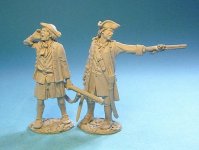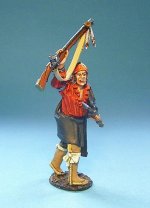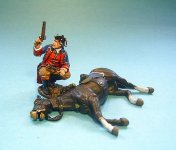Here is a separate update for collectors of the John Jenkins Club figures.
** PLEASE NOTE JJCLUBSET#06 WILL BE SHIPPING IN MID JUNE **
JJ DESIGNS COLLECTORS’ CLUB SET#10
STATUS –PREVIEW PERIOD, 15th MAY- 30th JUNE
Spendelowe was commissioned a lieutenant in the Royal Navy on May 1st, 1752. He commanded the detachment of sailors from the HMS Norwich, who served under Braddock in 1755.
He is best known for discovering the route around Wills Mountain, known as Spendelowe’s Road. He was killed at the Battle of Monongahela.
Midshipman Haynes was a naval officer who served in the detachment of Lieutenant Charles Spendelowe. He was killed at the Battle on The Monongahela.
JJCLUBSET-10
Battle On The Monongahela 1755
Lieutenant Spendelowe, and Midshipman Haynes
(2pcs)
Limited Edition (TBA)
Retail us$72
JJ DESIGNS COLLECTORS’ CLUB SET#09
STATUS –PRE-ORDER PERIOD, 15th MAY- 30th JUNE
John Norton (Teyoninhokarawen), (b c.1760 at Dunfermline, Scotland; d c.1831)
Captain John Norton or “The Snipe” was the son of a Cherokee father and a Scottish mother. Norton was a resourceful, intelligent war chief who participated in almost every major battle of the Niagara campaigns. After Tecumseh, he was the most successful British native leader of the war.
After receiving an education in Dunfermline, Norton enlisted in the British 65th Foot Regiment in 1784. He arrived in Lower Canada with the regiment in 1785, and was sent to Fort Niagara (Upper Canada) in 1787. Norton received his discharge in 1788, and worked in the fur trade from 1791-95 for John Askin, an American trader based in Fort Detroit, serving as both an interpreter and trader. He dealt with the First Nations south of the Great Lakes (Maumee, Wyandot, Shawnee). Following the victory of the American army over Maumee and their allies at the Battle of Fallen Timbers (20 Aug 1794), Norton returned to Canada.
Norton was retained by the Indian Department at Niagara as an interpreter, during which time he met Joseph Brant. Impressed by Norton's skill as an interpreter and negotiator, Brant convinced Norton to join the Grand River Mohawk. Norton resigned from the Indian Department. Brant adopted Norton as his nephew and granted him the title of Peace Chief, assigning him the task of negotiating land settlements with the British government. Norton was aided by Brant's son John, but they were unable to reach an agreement favourable to the Grand River Mohawk. During these negotiations, John Norton was approached by the British and Foreign Bible Society to translate the Gospel of St. John into the Mohawk language; when published in 1806, it was the first translation of the gospel in a First Nations' language.
With the outbreak of the WAR OF 1812 between Britain and the United States, Norton was given the rank of captain in the British army. He recruited Grand River Mohawk and others and led them at the BATTLE OF QUEENSTON HEIGHTS (13 October 1812). After the death of Sir Isaac Brock early in the battle, Norton led the Mohawk in the attack on the American troops. The action proved decisive, for it gave General Sheaffe time to prepare a successful counter attack and crush the American force.
The following year, Norton and his warriors covered the retreat of the British forces to Burlington Heights after the Americans had taken Fort Niagara. The American advance was halted at the BATTLE OF STONEY CREEK (6 June 1813), where Norton's Mohawk provided scouts prior to a successful night attack by Brigadier John Vincent and the 49th Regiment. Days later, the British completed the rout of the Americans at the BATTLE OF BEAVER DAMS (24 June 1813) with the aid of Grand River and Kahnawake Mohawk warriors.
After the war, Norton and his wife, a Lenape (Delaware) woman called Karighwaycagh, travelled to England where Norton received the brevet rank of major in the British army. They returned to Grand River in 1816. In 1823, Norton was found guilty of manslaughter after a duel involving his wife's suspected infidelity and after that he essentially disappeared from the historic record. The last known correspondence from him was in 1826. Unconfirmed reports indicate that Norton died in northern Mexico sometime in October 1831.
JJCLUBSET-09
THE WAR OF 1812 The Battle of Chippawa, 5th July 1814
Captain JOHN NORTON, “THE SNIPE”
Mohawk War Chief
(1pc)
Limited Edition (TBA)
Retail us$38
JJ DESIGNS COLLECTORS’ CLUB SET#08
STATUS –PRE-ORDER PERIOD APRIL 18th – MAY 31st
Stewart was a native of Scotland who fought and was wounded at the Battle of Great Meadows in July, 1754. He was promoted to captain in the Virginia forces on November 1st, 1754. Stewart commanded the troop of Virginia light horse on Braddock’s expedition. His unit served as escort for General Braddock and fought at the Battle on The Monongahela.
During the Battle he had two horses shot out from under him and his sword and scabbard were shot away. He was one of only five members of a 29 man unit that survived the battle, suffering only a slight injury when one bullet creased his brow and another his forehead.
JJCLUBSET-08
Battle On The Monongahela 1755
VIRGINIA LIGHT HORSE, CAPTAIN ROBERT STEWART, with Wounded Horse
(2pcs)
Limited Edition
Retail us$78
Hope this helps.
Mike
Sierra Toy Soldier Company


** PLEASE NOTE JJCLUBSET#06 WILL BE SHIPPING IN MID JUNE **
JJ DESIGNS COLLECTORS’ CLUB SET#10
STATUS –PREVIEW PERIOD, 15th MAY- 30th JUNE
Spendelowe was commissioned a lieutenant in the Royal Navy on May 1st, 1752. He commanded the detachment of sailors from the HMS Norwich, who served under Braddock in 1755.
He is best known for discovering the route around Wills Mountain, known as Spendelowe’s Road. He was killed at the Battle of Monongahela.
Midshipman Haynes was a naval officer who served in the detachment of Lieutenant Charles Spendelowe. He was killed at the Battle on The Monongahela.
JJCLUBSET-10
Battle On The Monongahela 1755
Lieutenant Spendelowe, and Midshipman Haynes
(2pcs)
Limited Edition (TBA)
Retail us$72
JJ DESIGNS COLLECTORS’ CLUB SET#09
STATUS –PRE-ORDER PERIOD, 15th MAY- 30th JUNE
John Norton (Teyoninhokarawen), (b c.1760 at Dunfermline, Scotland; d c.1831)
Captain John Norton or “The Snipe” was the son of a Cherokee father and a Scottish mother. Norton was a resourceful, intelligent war chief who participated in almost every major battle of the Niagara campaigns. After Tecumseh, he was the most successful British native leader of the war.
After receiving an education in Dunfermline, Norton enlisted in the British 65th Foot Regiment in 1784. He arrived in Lower Canada with the regiment in 1785, and was sent to Fort Niagara (Upper Canada) in 1787. Norton received his discharge in 1788, and worked in the fur trade from 1791-95 for John Askin, an American trader based in Fort Detroit, serving as both an interpreter and trader. He dealt with the First Nations south of the Great Lakes (Maumee, Wyandot, Shawnee). Following the victory of the American army over Maumee and their allies at the Battle of Fallen Timbers (20 Aug 1794), Norton returned to Canada.
Norton was retained by the Indian Department at Niagara as an interpreter, during which time he met Joseph Brant. Impressed by Norton's skill as an interpreter and negotiator, Brant convinced Norton to join the Grand River Mohawk. Norton resigned from the Indian Department. Brant adopted Norton as his nephew and granted him the title of Peace Chief, assigning him the task of negotiating land settlements with the British government. Norton was aided by Brant's son John, but they were unable to reach an agreement favourable to the Grand River Mohawk. During these negotiations, John Norton was approached by the British and Foreign Bible Society to translate the Gospel of St. John into the Mohawk language; when published in 1806, it was the first translation of the gospel in a First Nations' language.
With the outbreak of the WAR OF 1812 between Britain and the United States, Norton was given the rank of captain in the British army. He recruited Grand River Mohawk and others and led them at the BATTLE OF QUEENSTON HEIGHTS (13 October 1812). After the death of Sir Isaac Brock early in the battle, Norton led the Mohawk in the attack on the American troops. The action proved decisive, for it gave General Sheaffe time to prepare a successful counter attack and crush the American force.
The following year, Norton and his warriors covered the retreat of the British forces to Burlington Heights after the Americans had taken Fort Niagara. The American advance was halted at the BATTLE OF STONEY CREEK (6 June 1813), where Norton's Mohawk provided scouts prior to a successful night attack by Brigadier John Vincent and the 49th Regiment. Days later, the British completed the rout of the Americans at the BATTLE OF BEAVER DAMS (24 June 1813) with the aid of Grand River and Kahnawake Mohawk warriors.
After the war, Norton and his wife, a Lenape (Delaware) woman called Karighwaycagh, travelled to England where Norton received the brevet rank of major in the British army. They returned to Grand River in 1816. In 1823, Norton was found guilty of manslaughter after a duel involving his wife's suspected infidelity and after that he essentially disappeared from the historic record. The last known correspondence from him was in 1826. Unconfirmed reports indicate that Norton died in northern Mexico sometime in October 1831.
JJCLUBSET-09
THE WAR OF 1812 The Battle of Chippawa, 5th July 1814
Captain JOHN NORTON, “THE SNIPE”
Mohawk War Chief
(1pc)
Limited Edition (TBA)
Retail us$38
JJ DESIGNS COLLECTORS’ CLUB SET#08
STATUS –PRE-ORDER PERIOD APRIL 18th – MAY 31st
Stewart was a native of Scotland who fought and was wounded at the Battle of Great Meadows in July, 1754. He was promoted to captain in the Virginia forces on November 1st, 1754. Stewart commanded the troop of Virginia light horse on Braddock’s expedition. His unit served as escort for General Braddock and fought at the Battle on The Monongahela.
During the Battle he had two horses shot out from under him and his sword and scabbard were shot away. He was one of only five members of a 29 man unit that survived the battle, suffering only a slight injury when one bullet creased his brow and another his forehead.
JJCLUBSET-08
Battle On The Monongahela 1755
VIRGINIA LIGHT HORSE, CAPTAIN ROBERT STEWART, with Wounded Horse
(2pcs)
Limited Edition
Retail us$78
Hope this helps.
Mike
Sierra Toy Soldier Company




